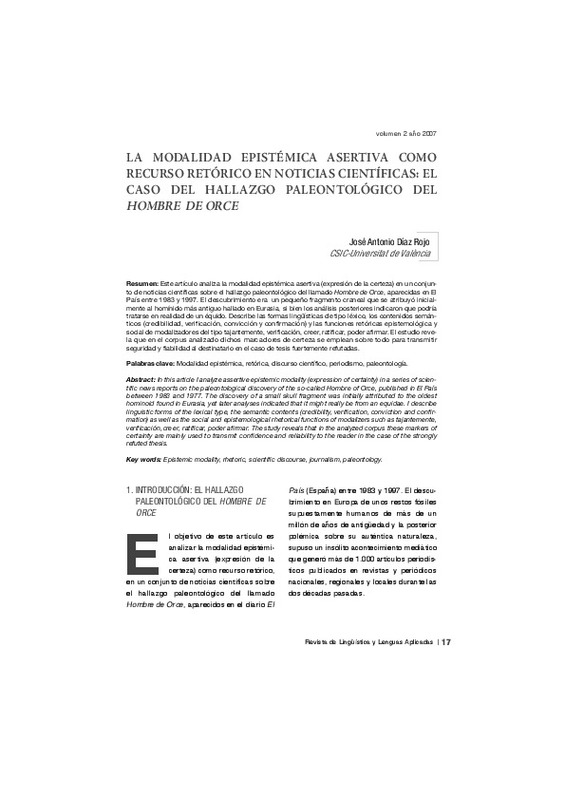JavaScript is disabled for your browser. Some features of this site may not work without it.
Buscar en RiuNet
Listar
Mi cuenta
Estadísticas
Ayuda RiuNet
Admin. UPV
LA MODALIDAD EPISTÉMICA ASERTIVA COMO RECURSO RETÓRICO EN NOTICIAS CIENTÍFICAS: EL CASO DEL HALLAZGO PALEONTOLÓGICO DEL HOMBRE DE ORCE
Mostrar el registro sencillo del ítem
Ficheros en el ítem
| dc.contributor.author | Díaz Rojo, José Antonio
|
|
| dc.date.accessioned | 2011-03-31T13:18:27Z | |
| dc.date.available | 2011-03-31T13:18:27Z | |
| dc.date.issued | 2007 | |
| dc.identifier.issn | 1886-2438 | |
| dc.identifier.uri | http://hdl.handle.net/10251/10622 | |
| dc.description.abstract | [EN] In this article I analyze assertive epistemic modality (expression of certainty) in a series of scientific news reports on the paleontological discovery of the so-called Hombre of Orce, published in El País between 1983 and 1977. The discovery of a small skull fragment was initially attributed to the oldest hominoid found in Eurasia, yet later analyses indicated that it might really be from an equidae. I describe linguistic forms of the lexical type, the semantic contents (cre d i b i l i t y, verification, conviction and confirmation) as well as the social and epistemological rhetorical functions of modalizers such as tajantemente, verificación, cre e r, ratificar, poder afirm a r. The study reveals that in the analyzed corpus these markers of certainty are mainly used to transmit confidence and reliability to the reader in the case of the strongly refuted thesis. | es_ES |
| dc.description.abstract | [ES] Este artículo analiza la modalidad epistémica asertiva (expresión de la certeza) en un conjunto de noticias científicas sobre el hallazgo paleontológico del llamado Hombre de Orce, aparecidas en El País entre 1983 y 1997. El descubrimiento era un pequeño fragmento craneal que se atribuyó inicialmente al homínido más antiguo hallado en Eurasia, si bien los análisis posteriores indicaron que podría tratarse en realidad de un équido. Describe las formas lingüísticas de tipo léxico, los contenidos semánticos (credibilidad, verificación, convicción y confirmación) y las funciones retóricas epistemológica y social de modalizadores del tipo tajantemente, verificación, creer, ratificar, poder afirmar. El estudio revela que en el corpus analizado dichos marc a d o res de certeza se emplean sobre todo para transmitir seguridad y fiabilidad al destinatario en el caso de tesis fuertemente refutadas. | |
| dc.language | Español | es_ES |
| dc.publisher | Editorial Universitat Politècnica de València | es_ES |
| dc.relation.ispartof | Revista de Lingüística y Lenguas Aplicadas | |
| dc.rights | Reserva de todos los derechos | es_ES |
| dc.subject | Modalidad epistémica | es_ES |
| dc.subject | Retórica | es_ES |
| dc.subject | Discurso científico | es_ES |
| dc.subject | Periodismo | es_ES |
| dc.subject | Paleontología | es_ES |
| dc.subject | Epistemic modality | es_ES |
| dc.subject | Rhetoric | es_ES |
| dc.subject | Scientific discourse | es_ES |
| dc.subject | Journalism | es_ES |
| dc.subject | Paleontology | es_ES |
| dc.title | LA MODALIDAD EPISTÉMICA ASERTIVA COMO RECURSO RETÓRICO EN NOTICIAS CIENTÍFICAS: EL CASO DEL HALLAZGO PALEONTOLÓGICO DEL HOMBRE DE ORCE | es_ES |
| dc.type | Artículo | es_ES |
| dc.date.updated | 2011-03-31T12:32:50Z | |
| dc.identifier.doi | 10.4995/rlyla.2007.698 | |
| dc.rights.accessRights | Abierto | es_ES |
| dc.description.bibliographicCitation | Díaz Rojo, JA. (2007). LA MODALIDAD EPISTÉMICA ASERTIVA COMO RECURSO RETÓRICO EN NOTICIAS CIENTÍFICAS: EL CASO DEL HALLAZGO PALEONTOLÓGICO DEL HOMBRE DE ORCE. Revista de Lingüística y Lenguas Aplicadas. 2:17-27. https://doi.org/10.4995/rlyla.2007.698 | es_ES |
| dc.description.accrualMethod | SWORD | es_ES |
| dc.relation.publisherversion | http://doi.org/10.4995/rlyla.2007.698 | |
| dc.description.upvformatpinicio | 17 | |
| dc.description.upvformatpfin | 27 | |
| dc.description.volume | 2 | |
| dc.identifier.eissn | 1886-6298 | es_ES |
| dc.description.references | Biber, D. y E. Finegan. (1989). "Styles of stance in English: lexical and grammatical marking of evidentiality and affect", Text 9-1: 93-124. | es_ES |
| dc.description.references | Campillo, D. (2002). El cráneo infantil de Orce: el homínido más antiguo de Eurasia. Barcelona: Bellaterra. | es_ES |
| dc.description.references | Chafe, W. (1986). "Evidentiality in English conversation and academic writing", en W. Chafe y J. Nichols (ed.) Evidentiality: The Linguistic Coding of Epistemological, cap. XVI, Nueva Jersey: Ablex Publishing Corporation: 261-271. | es_ES |
| dc.description.references | Ferrari, L. y S. Gallardo, (1999). "Los marcadores de evidencialidad empleados por la prensa en una controversia ambiental", Revista Iberoamericana de Discurso y Sociedad 1-4: 69-93. | es_ES |
| dc.description.references | Gallardo, S.(1999). "Evidencialidad: la certeza y la duda en los textos periodísticos sobre ciencia", RLA. Revista de Lingüística Téorica y Aplicada37: 53-66. | es_ES |
| dc.description.references | Gibert, J. (2004). El hombre de Orce: los homínidos que llegaron del Sur. Córdoba: Almuzara. | es_ES |
| dc.description.references | Hyland, K. (2000). Disciplinary discourses. Social interaction in academic writing. London: Logman. | es_ES |
| dc.description.references | Kovaci, O. (1999). "El adverbio", en I. Bosque y V. Demonte (eds.) Gramática descriptiva de la lengua española. Madrid: Espasa: 705-787. | es_ES |
| dc.description.references | López Ferrero, C. (2002). "La comunicación del saber en los géneros académicos: recursos lingüísticos de modalidad epistémica y de evidencialidad", en F. Luttikhuizen (ed.) V Congrés International sobre llengües per a finalitats específiques. The Language of International Communication. Barcelona: Publicacions de la Universitat de Barcelona: 164-172. | es_ES |
| dc.description.references | Palmer, F. (1986). Mood and Modality. Cambridge: Cambridge University Press. | es_ES |
| dc.description.references | Ridruejo,E.(1999)."Modo y modalidad. El modo en las subordinadas sustantivas", en I. Bosque y V. Demonte (eds.) Gramática descriptiva de la lengua española. Madrid: Espasa: 3209-3251 | es_ES |








